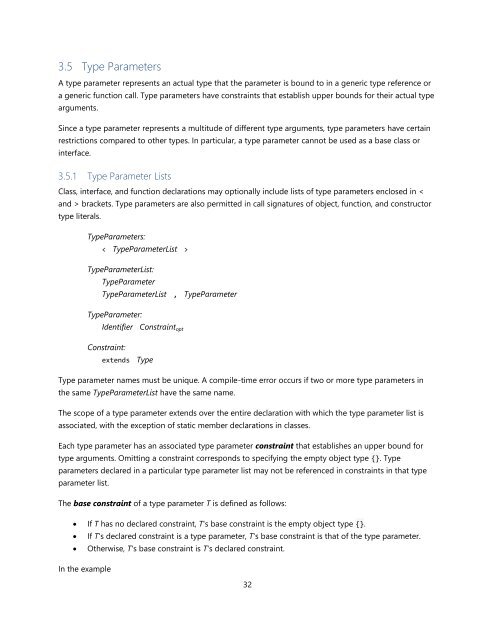TypeScript Language Specification v1.5
TypeScript Language Specification v1.5
TypeScript Language Specification v1.5
Create successful ePaper yourself
Turn your PDF publications into a flip-book with our unique Google optimized e-Paper software.
3.5 Type Parameters<br />
A type parameter represents an actual type that the parameter is bound to in a generic type reference or<br />
a generic function call. Type parameters have constraints that establish upper bounds for their actual type<br />
arguments.<br />
Since a type parameter represents a multitude of different type arguments, type parameters have certain<br />
restrictions compared to other types. In particular, a type parameter cannot be used as a base class or<br />
interface.<br />
3.5.1 Type Parameter Lists<br />
Class, interface, and function declarations may optionally include lists of type parameters enclosed in <<br />
and > brackets. Type parameters are also permitted in call signatures of object, function, and constructor<br />
type literals.<br />
TypeParameters:<br />
< TypeParameterList ><br />
TypeParameterList:<br />
TypeParameter<br />
TypeParameterList , TypeParameter<br />
TypeParameter:<br />
Identifier Constraint opt<br />
Constraint:<br />
extends Type<br />
Type parameter names must be unique. A compile-time error occurs if two or more type parameters in<br />
the same TypeParameterList have the same name.<br />
The scope of a type parameter extends over the entire declaration with which the type parameter list is<br />
associated, with the exception of static member declarations in classes.<br />
Each type parameter has an associated type parameter constraint that establishes an upper bound for<br />
type arguments. Omitting a constraint corresponds to specifying the empty object type {}. Type<br />
parameters declared in a particular type parameter list may not be referenced in constraints in that type<br />
parameter list.<br />
The base constraint of a type parameter T is defined as follows:<br />
If T has no declared constraint, T's base constraint is the empty object type {}.<br />
If T's declared constraint is a type parameter, T's base constraint is that of the type parameter.<br />
Otherwise, T's base constraint is T's declared constraint.<br />
In the example<br />
32


















